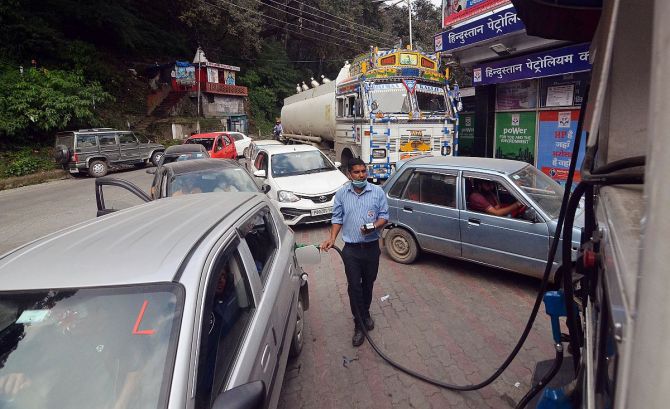India’s appetite for imported crude oil may wane in fiscal year (FY) 2023 from record levels in pre-pandemic 2019-20 fiscal as higher oil prices, a spillover from the conflict in Ukraine, and increasing use of biofuels affect domestic demand for petroleum products.

Brent crude surged to a nine-year high, shy of a July 2008 record $147.50 a barrel, before declining to around $100 a barrel — but the volatility in commodity rates will slow global economic growth and use of fuels.
Demand for all oil products may grow at only 2-3 per cent in FY23, slower than the current fiscal and nearly half the 5.5 per cent growth estimated by the petroleum ministry, according to industry officials.
Mumbai-based ratings agency ICRA expects petrol and diesel consumption, which together account for a little over half of India’s consumption basket, to grow 5 and 2 per cent next fiscal to 33 and 79 million tonnes, respectively, from a year earlier.
Slowing oil demand will in turn reduce India’s need for imported crude to meet domestic requirements, cushioning the impact of rising rates on the exchequer.
Crude imports fell 13 per cent last fiscal from a record 227 million tonnes in 2019-20.
It has since climbed by only 8 per cent in the April-January period, lower than the decline seen in the shutdown-led 2020-21, and will stay below pre-pandemic levels.
Import costs doubled to $94 billion during the period.
Every one per cent decline in oil use shaves off around 1.9 million tonnes in oil imports, while ethanol blending will obviate the need for another 3 million tonnes, which taken together helps save over $4 billion in import costs.
ICRA’s post-Ukraine estimates are lower than the 11 and 6 per cent in the growth of petrol and diesel seen in the April-January period from a year earlier, and 8 and 4 per cent forecast for 2022-23, according to oil ministry data, which pegs its estimates to $70 a barrel oil.
Diesel, India’s biggest consumed fuel, will continue to trail 2019-20 levels.
Consumption of fuels typically depends on GDP growth and domestic pump prices. Consumption of petrol, diesel, and LPG are not completely inelastic, or insulated from price hikes, said R Ramachandran, former refinery director, BPCL.
Sharp increases in petrol prices may prompt motorists to switch to public transport, while high diesel rates affect transport, industry and agriculture.
In villages, households have an option to shift to cheap firewood and biomass if LPG rates turn unaffordable, HPCL chairman M K Surana said.
There will be demand destruction globally if oil prices stay at $135 a barrel, Ramachandran added.
US bank Goldman Sachs increased its forecast for Brent crude by 38 per cent to $135 a barrel for 2022.
“We expect the price of the Indian basket of crude oil to remain volatile in the near term, until the geopolitical tensions ease or OPEC decides to materially raise the magnitude of production,” ICRA chief economist Aditi Nayar said.
International crude oil prices neared $140 a barrel earlier this month, fuelled by intensifying geopolitical tensions between Russia (the world’s third largest oil producer) and Ukraine, and the possibility of sanctions on Russia’s oil exports.
The price of the Indian crude oil basket has averaged $115 a barrel so far, 23 per cent higher from $93.3 a barrel in February.
Oil marketing companies are ready to increase rates to partially compensate for losses in the last four months after New Delhi informally halted adjustments of pump prices because of state polls.
Marketing losses may be around Rs 25 a litre but that is partially compensated by higher margins at the refinery gate, an industry official said.
The government may ask refiners to adjust some of the marketing losses with gains from refinery margins, the official added, moderating the impact of the price hikes on the motorist.
The monthly average retail selling prices of petrol and diesel in the four metro cities stayed unchanged at Rs 102.9/litre and Rs 90.5/litre, respectively, in March for the fourth consecutive month, despite a $41 a barrel increase in crude oil prices in this period.
Nomura expects pump prices to rise by around 10 per cent, and LPG by much more.
The total cesses levied on gasoline and diesel by New Delhi at Rs 27.9 and Rs 21.8 a litre, respectively, are higher than the rates levied during the pre-pandemic period of July 2019-March 2020 by Rs 8 and Rs 6 a litre, respectively, giving room for New Delhi to trim taxes.
At a broader level various brokerages have cut forecasts of India's FY23 GDP growth after Russia invaded Ukraine.
Only ratings agency Crisil is more sanguine about India’s oil demand.
It expects improvement in vehicle sales to raise petrol use 4-6 per cent in fiscal 2023.
With the economic recovery, demand for diesel is expected to improve 5-7 per cent in fiscal 2023, thus reaching close to pre-pandemic levels.
“With imports accounting for over 80 per cent of the total crude oil consumption, while we don’t expect India to be completely isolated from the ripple effects of the crisis, domestic fuel demand is expected to remain largely inelastic to these events,” said Hetal Gandhi, director, Crisil Research.











